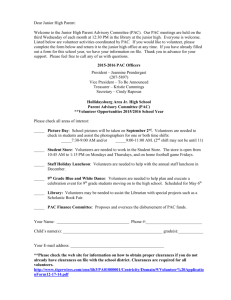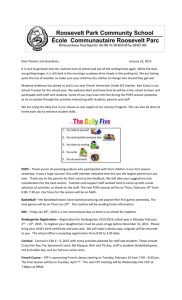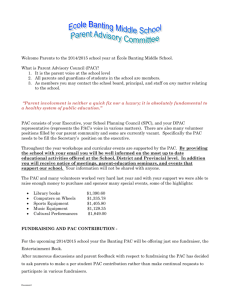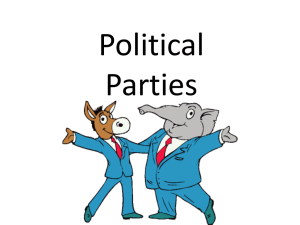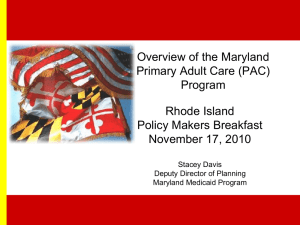Personal Politics: When Board Committees Supervise Corporate PACs
advertisement
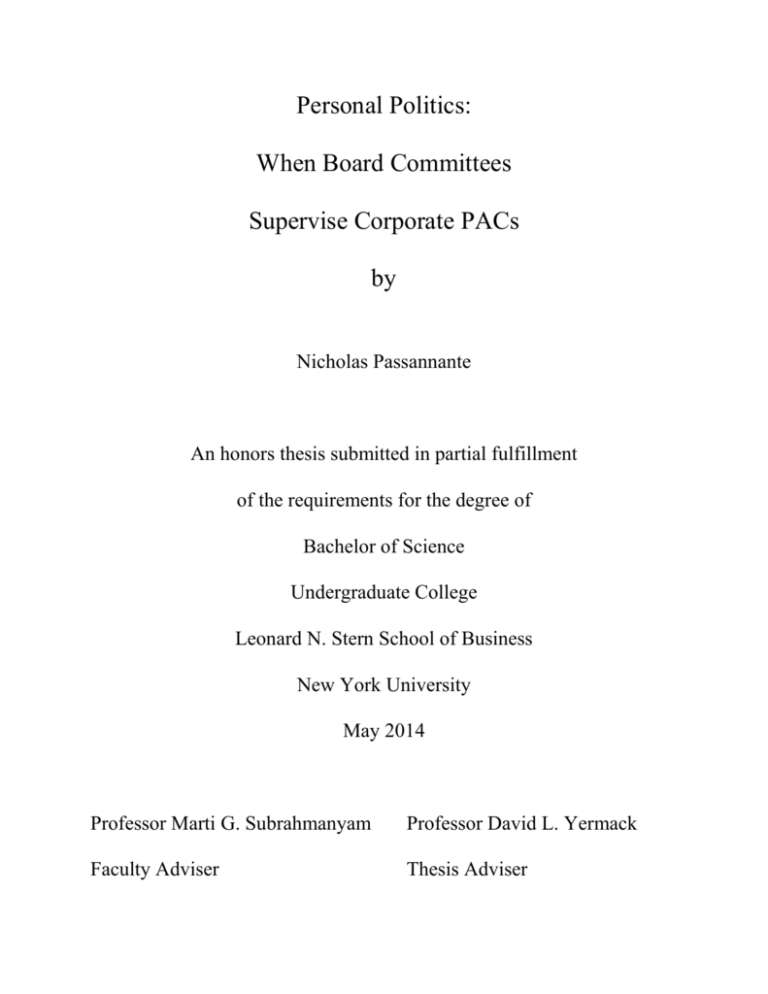
Personal Politics: When Board Committees Supervise Corporate PACs by Nicholas Passannante An honors thesis submitted in partial fulfillment of the requirements for the degree of Bachelor of Science Undergraduate College Leonard N. Stern School of Business New York University May 2014 Professor Marti G. Subrahmanyam Professor David L. Yermack Faculty Adviser Thesis Adviser Abstract Over the past decade, an increasing number of companies have formed board committees to supervise the activities of the firm’s PAC. In looking at individual firms and committees, the outcomes that these committees have are wide-ranging. Some address shareholder complaints about political spending, some do nothing, and some appear to introduce new conflicts of interest by allowing committee members with individual political motivations to dictate PAC contributions. This thesis attempts to establish the effect that committees overseeing PACs have on the partisanship of a firm’s PAC contributions by regressing the party split of PAC contributions with the political makeup of the supervising committee. The paper finds that there is statistically significant evidence to suggest that committee members allow their political leanings to influence the profile of the firm’s PAC contributions. Furthermore, committee members that are politicians have an outsized effect on PAC contributions relative to members who are not politicians. Acknowledgements A sincere thank you to Professor David Yermack for his constant availability and guidance throughout this year. I would have been in the dark on my own, but with your help I always knew where I was going. And another thank you to Professor Marti Subrahmanyam for putting this program together; it has been fun. Table of Contents 1. Introduction ........................................................................................................................................... 1 2. Hypothesis.............................................................................................................................................. 3 2.1. PAC partisanship follows the personal ideologies of committee members .................................. 3 2.2. Heinz as an illustration of personal politics on committees ........................................................... 5 2.3. Alternative #1: Committees reduce PAC partisanship and enhance shareholder value ............... 7 2.4. Harris Corporation illustrates the optimistic view of committees ................................................. 9 2.5. Alternative #2: Committees have no meaningful impact on PAC partisanship ........................... 10 3. Sample & Data ..................................................................................................................................... 13 3.1. Corporate Political Contributions ................................................................................................ 13 3.2. Board Committees ....................................................................................................................... 14 3.3. Control Variables ......................................................................................................................... 15 4. Results .................................................................................................................................................. 18 4.1. Political ideology of committee members and PAC contributions ............................................ 18 4.2. Changes in committee composition and PAC contributions ...................................................... 21 5. Interpretation of Results ..................................................................................................................... 24 5.1. There is little evidence to support the optimistic view of committees ...................................... 24 5.2. The window-dressing hypothesis isn’t supported by the results .............................................. 26 5.3. The regressions offer the most support for the personal politics hypothesis ........................... 27 6. Politicians on Committees ................................................................................................................... 29 7. Other Avenues for Further Research .................................................................................................. 33 8. References............................................................................................................................................ 35 1. Introduction In 2010, the U.S. Supreme Court issued its extremely controversial decision on Citizens United v. Federal Election Commission. The decision overturned 2002’s McCain-Feingold campaign finance reform and in the process spawned significant anxiety regarding the role of big money players in the American political process. In particular, Citizens United eliminated McCainFeingold’s limitations on corporate independent expenditures (expenditures that are for or against a candidate but not made in coordination with a candidate’s campaign). As such, a common criticism that arose in the wake of the decision was that these allowances would allow corporate Political Action Committees (PACs) to buy off elections and candidates with their new-found spending privileges. Russ Feingold, one of the cosponsors of McCain-Feingold, declared that elections would become “financially dominated by big money, including, whether directly or indirectly, big money from the treasuries of corporations of all kinds.”1 Whether this prophesy will come to pass is debatable, but one consequence of this new-found corporate freedom is reinvigorated scrutiny towards the corporate role in elections. This is not to say that public scrutiny over corporate involvement in politics is a new phenomenon. John Paul Stevens noted in his dissent in Citizens United that the American people “have fought against the distinctive corrupting potential of corporate electioneering since the days of Theodore Roosevelt.”2 One of the most frequent targets of public ire has been corporate PAC contributions in federal elections, even though they tend to comprise a small fraction of total corporate political activity. Even years before the issuance of Citizens United, the public view of corporate PACs was exceedingly negative. In 1995, the director of the National Association of Business 1 Feingold, Russ. "The Money Crisis: How Citizens United Undermines Our Elections and the Supreme Court." Stanford Law Review Online. 31 Mar. 2014. 2 Citizens United v. FEC, 130 S. Ct. 876, 979 (2010) (Stevens, J., concurring in part and dissenting in part). 1 PACs claimed that media attention given to corporate PACs was more negative than that given to the Oklahoma City bomber.3 Because of the exceedingly negative publicity that they attract, corporate PACs have become a target for activist shareholders. From 1997 to 2011, S&P 500 companies received 382 shareholder proposals requesting disclosure on PAC activity and, in some cases, a cessation of political contributions. For proposals with available voting results, an average of 18.7% of shares voted in favor of the proposals—a sign that some of these measures are getting real traction. Besides the threat of corruption detailed above, these shareholders are also concerned that management could be throwing away money on useless political endeavors, supporting political stances they do not identify with, or even embezzling the firm’s funds to support their favorite party or candidate (generally Republicans). These concerns have led some corporations to take the keys away from management and place their PACs under the supervision of a board committee, generally composed of outside directors. These committees are the focus of study for this paper. When a corporation introduces a novel corporate governance mechanism, it is important to ask whether the mechanism is actually effective at addressing shareholder concerns. For shareholders, the wish list for these committees would probably include some combination of disclosure, reduced contributions, and greater balance between the parties in contributions. Because these committees have never been studied, I seek to answer a fairly simple question – what effect, if any, do board committees have on the partisanship of a firm’s PAC contributions? 3 Statement before the Committee on House Oversight, 16 November 1995, United States House of Representatives. 2 2. Hypothesis For the purpose of answering my research question, I formulated a hypothesis as well as two alternatives that could explain the mechanism of committees overseeing PACs. 2.1. PAC partisanship follows the personal ideologies of committee members The hypothesis that I test in this paper is that the committees overseeing PACs cause PAC contributions to shift towards the party favored by the personal ideologies of the committee’s members. That is to say that a committee composed of Republicans will shift more PAC funds to Republicans and a committee composed of Democrats will shift more PAC funds to Democrats. The logic underlying this hypothesis is that creating a committee does not really solve the conflict of interest involved when management is overseeing the firm’s PAC; it merely passes the buck to committee members who may have the same political motivations that management does. This problem is exacerbated by the inherent difficulties of evaluating the efficacy of a PAC’s contributions. There is frequent debate about whether campaign contributions are even a profitable investment. The two benefits most often argued are that PAC contributions can buy votes for legislation and that PAC contributions can buy access as an antecedent to lobbying. 4 Lobbying can help the passage of legislation, and some research has also found a correlation between lobbying expenditures and reductions in effective tax rate in the following year.5 There 4 Milyo, Jeffrey, David Primo, and Timothy Groseclose. "Corporate PAC Campaign Contributions in Perspective." Business and Politics 2.1 (2000): 75-88. Web. 5 Richter, Brian Kellher, Krislert Samphantharak, and Jeffrey F. Timmons. “Lobbying and Taxes.” American Journal of Political Science 53.4 (2008): 893-909. Web. 3 is no conclusive evidence for either benefit, although it seems more likely that contributions buy access. In such a case, campaign contributions may only yield fruit years down the line—for example, when a senator provides support on a key piece of legislation because the firm had access for lobbying. As such, evaluating the efficacy of a PAC’s contribution strategy is nigh impossible for exterior shareholders. People outside the company have no access to information regarding the wheeling-and-dealing that management (or its lobbyists) does with politicians. The only outcome information exterior shareholders have is when legislation passes or fails. However, this information is decidedly lacking. Not only are the benefits of legislation often difficult to forecast and interpret, but there is also no way to tell if management actually influenced the legislative process in a meaningful way. Because of this lack of information, the committees overseeing corporate PACs do not have meaningful accountability to shareholders. Assuming a nefarious committee, it would be possible for the committee’s members to funnel PAC funds towards the party and candidates that suit the members’ personal political ideology while avoiding reprisal. While contributing heavily to a single party might be justifiable in the name of increased profits, doing so in pursuit of personal ideology would be difficult to defend. Unfortunately, without any real performance standards offended shareholders have scarce ground to stand on when accusing the committee of malfeasance. 4 2.2. Heinz as an illustration of personal politics on committees H.J. Heinz Co. provides a good example of what it might look like when committee members allow personal politics to influence PAC contributions. In the 1998 election cycle, Heinz made a mere 52% of its total contributions to Republicans. The committee’s political composition was relatively diverse. 57% of members were Republican, 29% were Democrats, and 14% were independent. Midway through the 2000 cycle, there were a number of departures from the committee. In all, one independent, one Republican, and two Democrats left the committee. One of the Democrats that left was Eleanor Sheldon, who was until then the chairperson of the committee. To replace these committee members, Heinz selected two Republicans. Thomas J Usher, one of these Republicans, personally contributed over $73,000 to Republican campaigns from 1990 to 2012. Furthermore, Heinz selected existing Republican member Mary Choksi to fill the vacant committee chair. Choksi personally contributed nearly $20,000 to Republicans from 1999 to 2008. Figure 1 Heinz PAC Contributions 100 90 80 Committee R% 70 Contributions to R% 60 50 40 1998 2000 2002 2004 2006 2008 2010 2012 5 By the time this membership turnover was complete, Heinz’s committee was composed entirely of Republicans. In fact, the committee would continue to be composed entirely of Republicans through the 2004 cycle. Figure 1 displays the percentage of PAC funds that went to Republicans compared to the percentage of Heinz’s committee that was Republican during the cycle. During the period where Heinz’s committee was completely Republican, Heinz made an average of 77.3% of its PAC contributions to Republicans, a stunning 25.3% differential when compared to the firm’s 1998 figure. Furthermore, gross PAC contributions rose substantially during this period. For the 1998 cycle, total contributions amounted to $37,500; by 2004, contributions had risen to $156,562. In the 2006 cycle, Heinz added a single Democrat member to the committee. The addition had a noticeable impact in balancing the PAC’s contributions. The firm’s contributions to Republicans dropped by 8% from 2004, and from 2006 to 2012 the overall yearly average of contributions to Republicans was 55%. Gross PAC contributions also decreased. From 2004 to 2006, contributions dropped by nearly $29,000. Heinz’s PAC contributions would not exceed 2004’s total until the 2012 cycle when they hit $167,000. The political contributions of Heinz’s PAC cannot be entirely reduced to the political identities of the constituents of the overseeing committee. National political factors naturally have some impact. Many companies were contributing heavily to Republicans during the 2000-2004 cycles, and gross PAC contributions have been on the rise for the past decade. Even accounting for these factors, however, the contribution pattern of Heinz’s PAC is aberrant. 6 Heinz’s contributions to Republicans spiked in 2000 despite the fact that for S&P 500 firms Republican contributions peaked in the 1998 cycle before tailing off slightly in 2000. Although Bush was elected during this cycle, party control of Congress is a superior predictor of where corporate contributions flow; of course, Republicans already had control of both houses in 1998. Given how Heinz’s gross contributions and contributions to Republicans spiked during the 20002004 period, it would appear that when the Democrats are away, the Republicans will play. The only aspect of Heinz’s contribution pattern that does not fit this narrative is that there was a drop-off in Republican contributions from the 2000 peak even though there were no Democrats in the committee. It is not clear why Republican contributions would tail off, but it is possible that the committee members felt external pressure to curtail contributions to Republicans given that the PAC’s contribution profile deviated so wildly from the company’s relatively neutral 1998 figures. Unfortunately, it is difficult to prove this notion without access to internal information. Either way, what is clear is that Heinz’s PAC contributions only returned to relative neutrality once the committee began including Democrats again. 2.3. Alternative #1: Committees reduce PAC partisanship and enhance shareholder value On the face of it, placing corporate PACs under the authority of a corporate board committee could be a useful measure for subordinating PAC expenditures to the creation of shareholder value. As was mentioned earlier, these committees are for the most part composed of outside directors. The optimistic shareholder expectation for an independent oversight committee would be that the members of the committee use their best judgment to direct PAC funds towards 7 candidates that are likely to help create shareholder value. If these committees indeed function in this way, they can be useful to both management and shareholders. For management, the committee can provide a method to defuse shareholder complaints regarding the corporation’s contribution patterns. As was explained in the introduction, corporate PACs attract substantial controversy on their own. This controversy is only exacerbated when corporations have contribution patterns that are ideologically opposed to those of the corporation’s shareholders. It is not difficult to imagine why a corporation contributing heavily to Republicans might cause a liberal shareholder to raise objections. However, if management implements an independent committee to supervise the PAC, then they have a way to defend themselves from shareholder complaints. The committee would ostensibly ensure that contributions are for the sake of the bottom line and would rationalize any discrepancies in the partisanship of the corporation’s PAC. For shareholders, the committee can provide the aforementioned assurance of a contribution strategy that is effective at creating shareholder value. The committee could also reduce the partisanship of a corporation’s political contribution strategy. If the committee determines that there isn’t a significant advantage to a heavily partisan strategy, it may very well decide that a strategy that doesn’t heavily favor either party is advantageous, if only for the sake of placating unhappy shareholders. The committee could also elect to reduce the overall level of campaign contributions if they determine that campaign contributions are an ineffective means of increasing shareholder value. Once again, this would help to satisfy activist shareholders that are dissatisfied with the corporation’s political strategy. 8 2.4. Harris Corporation illustrates the optimistic view of committees Harris Corporation provides a strong piece of anecdotal evidence in favor of this explanation. During the 2006 election cycle, Harris Corp formed a committee to oversee its corporate PAC. From 1998 to 2006, Harris Corp contributed a staggering yearly average of 98.8% of its PAC funds to Republicans, and in the 2006 cycle not a dime went to Democrats. As it happens, the CEOs of Harris Corp during this period, Phillip W. Farmer and Howard L. Lance both made the vast majority of their political contributions to Republican campaigns. There may have been other factors at work besides the political ideology of management, but a contribution profile as extreme as Harris Corp’s does not happen by accident. In 2008, the cycle after the committee’s creation, only 55% of PAC funds went to Republicans, as Figure 2 illustrates. From 2008-2012, the average percentage of funds contributed to Republicans by Harris Corp was 51.3%. Figure 2 Harris Corp PAC (% to Republicans) 100 90 80 70 60 50 40 30 1998 2000 2002 2004 2006 2008 2010 2012 Perhaps just as impressive is that Harris Corp’s committee had a Republican plurality through 2012. Republicans comprised an average of 45% of the committee compared to 33% for independents and 22% for Democrats. Harris Corp appears to have been very successful at 9 creating a committee that was not only independent from management but was also not allowing personal political ideology to affect their decision making. National political factors in 2008 were conducive to reduced Republican contributions, but the extent to which Harris Corp evened its contributions could only be the result of a conscientious decision to do so. Although Harris Corp continued to increase gross PAC contributions over this period, it is plausible that Harris Corp’s balanced contribution strategy could yield greater shareholder value. Contributing all PAC funds to Republicans when they do not control either house of Congress certainly seems like a losing proposition. At the very least, the new contribution strategy is less likely to attract negative attention from Democrat and independent shareholders, a victory for shareholders and management alike. 2.5. Alternative #2: Committees have no meaningful impact on PAC partisanship Another possible alternative to my initial hypothesis is that committees may have no impact at all on PACs, functioning as corporate governance window-dressing. This explanation presumes that the corporations that implement committees to oversee PACs care more about the public perception of their political contributions than any performance gains that may be gained through independent oversight. This window-dressing explanation has some credence because PAC contributions are, in some sense, a problem of public perception. Take General Electric, for example. General Electric is consistently among the top corporate PACs in terms of gross contributions. In the 2012 election cycle, General Electric’s PAC contributed just under $2.9 Million to political campaigns. In comparison, General Electric spent over $45 million to lobby the government over the same period, and has spent as much as $39 10 million in lobbying in a single year. Although General Electric is a particularly heavy lobbying spender because it is a government contractor, one study found that, as a whole, corporate lobbying expenses are at least an order of magnitude larger than corporate PAC contributions.6 If the corporate PAC problem is a problem of perception, then committees offer a potentially convenient and low-cost solution. As was explained previously, committees can address shareholder concerns, at least on paper. Conceding a toothless committee to shareholders in exchange for making them less vocal is certainly more convenient than a meaningful evaluation of the corporation’s contribution practices followed by a systematic overhaul. After all, management’s incentive to change PAC practices is small if only because lobbying expenses have a much more tangible impact on the bottom line. Of course, this all presumes that shareholders are satisfied by the committee alone and do not demand demonstrable changes to the firm’s contributions. ConocoPhillips, for example, did not significantly change its political contribution strategy following the implementation of its committee. From 1998-2000, ConocoPhillips contributed an average of 87.5% of its PAC funds to Republicans. This highly partisan strategy would appear to be a prime target for revision by an independent board committee. However, ConocoPhillips’s average contribution to Republicans after the committee’s implementation was 85.8%. In terms of partisanship, the committee’s creation was barely noticeable. Gross PAC contributions also continued to grow unabated despite the committee’s creation, from $189,778 in 2002 to $647,288 in 2012. The committee may have changed the PAC’s strategy in other ways, but if it did those changes are not readily observable to outsiders. Unfortunately for ConocoPhillips, the 6 Milyo, Primo, and Groseclose. 11 committee appears to have failed in deflecting negative shareholder attention. From 2007-2011, the company received six shareholder proposals requesting disclosure on political contributions and policy. 12 3. Sample & Data Figure 3 Variables N Mean Median SD 10% 90% Pretax ROA 2196 7.85% 6.38% 9.07% 0.6% 18.27% log(Total Assets) 2196 4.223 4.188 0.647 3.52 5.01 President Vote R% 2204 46% 46% 9% 36% 57% Committee D% 274 41% 40% 22% 14% 71% Committee I% 274 14% 13% 15% 0% 33% Committee R% 274 45% 44% 23% 18% 75% Congress Control (R) 2204 1.29 2 0.878 0 2 Telecoms Industry (Dummy) 2204 0.014 0 0.118 0 0 Energy Industry (Dummy) 2204 0.076 0 0.265 0 0 Defense Industry (Dummy) 2204 0.019 0 0.139 0 0 Materials Industry (Dummy) 2204 0.025 0 0.156 0 0 Mining Industry (Dummy) 2204 0.015 0 0.121 0 0 3.1. Corporate Political Contributions My sample is a panel of the 500 largest publicly traded companies in the United States (S&P 500) from 1998 to 2012. A summary of the data collected on the sample is displayed in Figure 3. Data on the political contributions of each company were obtained from OpenSecrets.org’s Political Action Committee (PAC) database. OpenSecrets provides contribution data on 339 S&P 500 companies during the sample period. PAC data on OpenSecrets is organized into two-year 13 election cycles, and provides total contribution figures, party splits, individual recipients of PAC funds (such as congressmen and other PACS), and individual contributors to the PAC. For the purpose of this paper, the primary figure I use is the party split of each firm-cycle. Although OpenSecrets has PAC data going back to the 1990 election cycle, precise contribution and party split figures are only readily accessible beginning with the 1998 cycle. My sample also excluded firm-cycles in which the firm’s PAC contributed less than $1000. This was done to prevent pollution of the party split metric, as a single small contribution during a politically inactive firm-cycle could be misrepresented as an extremely partisan firm-cycle. This selection process resulted in a total sample size of 2204 firm-cycle observations. The average total PAC contribution for each firm-cycle was $426,048. Furthermore, average PAC expenditures grew significantly between 1998 and 2012, from $219,593 to $592,764. 3.2. Board Committees Data on the board committees at the center of this paper were obtained by using the DEF 14A Proxy Statements of each company. To identify the existence of these committees I programmed a search algorithm that checked each proxy statement for text strings containing “committee” in addition to a keyword identifying political responsibilities (such as “public policy”). These committees were then verified by a manual check of the proxy statement. I also checked each committee’s charter to ensure that the committee was responsible for overseeing the company’s PAC contributions or relationship with the government. This process yielded 49 committees for study, and a total of 274 firm-cycles with a committee present. To establish the party leanings of each committee member, I looked up each person on 14 OpenSecrets’ individual donor database. Cross-referencing the member’s name with their occupation and address, I was able to find donation records for the vast majority of members. Because the donation records data was both substantial and not readily downloadable, it wasn’t feasible to use a precise cutoff point for partisanship. I used a rough cutoff of around 70% to determine my classifications, along with supporting factors such as large contributions to national parties. For example, if a member has roughly 70% of his donations go to Republicans, I would classify him as such. If the member is a bit below this cutoff point and donated directly to the Republican Party (rather than a candidate), I would also classify him as Republican. Most of the members weren’t this marginal, however. When I couldn’t satisfactorily determine a member’s affiliation, I classified him as independent. This classification also includes members with no donation records, including international members. In aggregate, the typical committee had 4.5 members, with 2.0 Republican members, 1.8 Democrat members, and 0.7 independent members. 3.3. Control Variables My regression model includes several firm-level controls, including the log of total assets, pretax return on assets (ROA), and industry controls. Accounting figures for total assets and ROA were obtained from the Compustat Fundamentals Annual database. To convert these annual figures into election cycle figures, I took a simple average of each cycles component years. Political contribution profiles vary significantly by industry. Firms in the energy industry, for example, make 75% of their contributions to Republican candidates, which is 15% above the overall sample average of 60%. The telecommunications industry, in contrast, makes only 54% 15 of its contributions to Republicans. To control for these variations, each firm was assigned an industry based on Standard & Poor’s Global Industry Classification Standard (GICS). For industries where political contributions varied significantly from the overall sample, I assigned a dummy variable. These industries include energy, defense, mining, telecommunications, and materials (which includes manufacturers of commodities like glass, paper, steel, and so on). I also included a control to account for the company’s local political climate, which may exert pressure on the company to contribute more heavily to one party. The control I used was the percentage of voters that voted for the Republican presidential candidate in the state the firm is headquartered. For headquarters location data, I used the Compustat Fundamentals Annual database, and for election results I used data available on the Federal Election Commission website. This data isn’t perfect, as it only refreshes every four years, but it provides a sufficient proxy for the company’s immediate political environment. The overall Republican vote average for all firm-cycles was 45.9%. The last control I included was for the national political environment. The variable I used was the number of Congressional houses controlled by Republicans. To illustrate the impact of congressional control on PAC activity, Figure 4 displays the percentage of sample PAC contributions that go to Republicans each cycle. Prior to the 2008 cycle, Republicans controlled both houses of Congress and received an average of 67.1% of the contributions of corporate PACs in the sample. When the Democrats took control of both houses in the 2008 cycle, the overall profile shifted dramatically. In the 2008 and 2010 cycles, only 50.4% of sample PAC contributions went to Republicans. There are several possible explanations for this. National 16 political trends could place pressure on companies to throw more support to the leading party. Alternatively, the political necessities of a company’s business may require contributions to the party in power in order to buy access and influence over key legislation. Either way, once the Republicans took back control of the House of Representatives in the 2012 cycle the Republican share of sample PAC contributions rose back to 62.9%. Figure 4 These political controls are especially important because there of the correlation between a firm’s political environment and who ends up serving on the board committees overseeing PACs. For example, when Democrats control Congress, firms may end up selecting more Democrats to serve on committees than when Republicans control Congress. Indeed, the correlation between Republican membership percentage on committees and the number of houses of Congress controlled by Republicans is a positive 0.60. 17 4. Results 4.1. Political ideology of committee members and PAC contributions In Figure 5, I examine the relationship between the compositions of political board committees (treated as independent variables in the regression) and the profile of the firm’s PAC contributions. I examined this relationship using ordinary least squares regression. The measure I used to represent firm PAC contributions is the percentage of contributions going to Republicans; ergo, a positive coefficient represents greater contributions to Republicans and a negative coefficient represents greater contributions to Democrats. Finally, because the composition figures (D%, I%, R%) are perfectly collinear, I dropped the Committee I% measure from the regression. Figure 5 Variables Coeff. (1) t-stat (1) Coeff. (2) t-stat (2) Coeff. (3) t-stat (3) Coeff. (4) t-stat (4) Committee D% -11.09 -3.42 -9.67 -3.05 -9.29 -2.92 -5.41 -1.91 Committee R% 10.68 3.59 8.22 2.81 8.13 2.77 6.59 2.54 Telecoms Industry -5.84 -1.73 -5.33 -1.58 -7.47 -2.49 Energy Industry 14.50 9.67 14.29 9.50 9.08 6.51 Defense Industry -4.45 -1.56 -4.49 -1.57 -3.76 -1.49 Materials Industry 12.51 4.89 12.69 4.92 10.08 4.38 Mining Industry -0.18 -0.06 -0.71 -0.22 -2.02 -0.69 log(Total Assets) -0.77 -1.09 1.55 2.44 Pre-tax ROA 0.13 2.79 0.18 4.56 President Vote R% 62.57 13.51 Congress Control (R) 7.45 18.25 R-Squared 0.007 0.007 0.056 0.056 0.064 0.064 0.267 0.267 Observations 2204 2204 2204 2204 2196 2196 2196 2196 18 The first regression in the table estimates the committee coefficients absent firm-level and cyclelevel controls. In this regression, the coefficient estimate is -11.09 for the Democrat composition variable and 10.68 for the Republican composition variable, with t-statistics of -3.42 and 3.59 respectively. This means that a committee that is composed entirely of Democrats is associated with an 11.09 point reduction in PAC contributions to Republicans, with the opposite being true for an entirely Republican committee. These results support the hypothesis that the members of these board committees use their position to support their personal politics. The second regression in the table introduces industry controls. Controls for the energy and materials industries had coefficients of 14.50 and 12.51 (with t-statistics of 9.67 and 4.89 respectively). These results are not surprising – the energy industry in particular is known for being aggressively Republican in its political activity. The introduction of industry variables adulterated the committee compositions variable slightly, but the relationships are still statistically significant. The third regression introduces firm-level financial controls. Pre-tax ROA (expressed as a percentage) has a coefficient of 0.13 with a t-statistic of 2.79. This relationship suggests that more profitable companies tend to donate more to Republicans. The reason underlying this relationship isn’t readily discernible. It could be a case of reverse causation, where contributions to Republicans generate more profitable political favors than contributions to Democrats. It could also be a by-product of Democrat contributions peaking during the economic woes that began in 2008. 19 The fourth regression introduces controls for local and national political environment. Both of these variables have very strong relationships with the firm’s PAC contributions, and are significant explanatory variables as evidenced by the jump in R-Squared. The local variable (President Vote R%) has a coefficient of 62.57, with a huge t-statistic of 13.51. This relationship suggests that more than anything else, firms tailor their political contributions to their local political environment. The national political environment also has a significant association with corporate political contribution decisions; the congressional control variable has a coefficient of 7.45 and a t-statistic of 18.25. As touched upon earlier, this relationship is backed up by overall trends in corporate political donations since 1998, and it is not wild to suggest that corporations seek clout with the party in power. The introduction of political control variables further dilutes the variables of interest in this paper, with the Democrat coefficient dropping to -5.41 and the Republican coefficient dropping to 6.59 (t-statistics of -1.91 and 2.54). This is in all likelihood a result of the correlation between firm political environment and committee membership that was touched upon earlier in the paper. Whether the forces underlying shifts in committee membership between cycles were the same as those that caused the shift in PAC contributions are the same is debatable. However, it is a fact that average Democrat membership on committees from 2008-2012 was four points above the average from 1998-2006. Although the introduction of these controls causes the Democrat tstatistic to dip slightly below statistical significance, the earlier iterations of the regression give sufficient cause to consider it as evidence of personal politics. What it may also suggest is that Democrat committee members are marginally less effective at influencing PAC contributions than Republican members. On an intuitive basis, this makes sense, as firms within the sample 20 lean heavily Republican anyways. It would probably be more difficult for a Democrat to come in to a Republican-leaning firm and divert PAC funds than it would be for a Republican member, all else being equal. 4.2. Changes in committee composition and PAC contributions The second set of regression analyses that I performed (visible in Figure 6) were on the same set of variables as the previous regressions, only using the cycle-to-cycle deltas of the variables rather than the raw figures (except for industry dummies). The objective in applying this analysis was to attempt to isolate the impact that changes in committee composition have on corporate PAC activity. The previous regression provides evidence of a connection between the component political ideologies of a committee and PAC activity, but is susceptible to the influence of variables that are unobserved in the regression model. This method does not entirely eliminate this weakness, but by reducing the impact of observations where there is not committee turnover or changes in PAC contributions the impact of unseen variables is lessened. The first regression presents the results absent any firm-level or cycle-level controls. The results largely reflect what was observed in the first set of regressions, albeit with insignificant tstatistics. This may be because static observations had an outsized impact on the previous model. There were a number of observations in the previous sample, for example, of firms with highly Republican committees and highly Republican PAC contributions across all cycles. The deltas of these cycles would be small or zero, so they are not pushing up the variables coefficient or tstatistic. Alternatively, it could be because the impact of the marginal committee member’s political ideology is small compared to the political ideology of the long-tenured core committee 21 members that are around year after year. After all, new members may be less likely to rock the boat and demand wholesale change of entrenched committee behavior. Figure 6 Variables Coeff. (1) t-stat (1) Coeff. (2) t-stat (2) Coeff. (3) t-stat (3) Coeff. (4) t-stat (4) ΔCommittee D% -2.91 -0.55 -2.71 -0.51 -2.58 -0.49 -1.72 -0.37 ΔCommittee R% 5.05 1.00 4.67 0.92 5.09 1.00 6.29 1.38 Telecoms Industry -2.33 -0.79 -2.17 -0.73 -1.91 -0.72 Energy Industry 3.01 2.29 3.09 2.34 2.86 2.42 Defense Industry -0.56 -0.22 -0.65 -0.26 -0.53 -0.24 Materials Industry -1.27 -0.57 -1.28 -0.57 -1.37 -0.69 Mining Industry 0.89 0.31 0.95 0.33 0.92 0.36 Δlog(Total Assets) -2.37 -1.38 -1.03 -0.67 ΔPre-tax ROA 0.11 2.61 0.09 2.26 ΔPresident Vote R% 4.85 0.59 ΔCongress Control (R) 8.90 22.25 R-Squared 0.001 0.001 0.004 0.004 0.008 0.008 0.205 0.205 Observations 2204 2204 2204 2204 2196 2196 2196 2196 The second regression introduces the same industry dummy variables as in the previous set of regressions. The second regression more or less preserves the relationships of the first with only slight changes. Also of note is that the Energy industry is the only statistically significant dummy in this model, although it is difficult to draw any conclusions about what is happening with dummy variables in a model where everything else is a delta of the original variable. The third regression introduces firm-wide controls to the model. Once again, the relationships of interest to this paper are largely unchanged. Furthermore, the relationship between pre-tax ROA and PAC contributions receives some confirmation in this regression. In the previous model, 22 high ROAs were associated with Republican PAC contributions. In this model, we can see that increases in ROA are associated with increases in Republican PAC contributions. The final regression introduces cycle-level local and national political controls. Congressional control continues to be by far the most significant determinant of where PAC contributions flow, with a t-statistic of 22.25. On the other hand, the local control variable, President Vote R%, is insignificant, despite having a huge t-statistic in the first model. This is most likely just a quirk of the model – because presidential election results only refresh every four years, there is only a nonzero delta for this variable every other cycle. The addition of these controls also increases the t-statistic for Committee R%, but the relationship remains insignificant. At the end of the day, this model helps confirm some of the relationships of control variables in the previous models, but doesn’t say much either way when it comes to the variables of interest. 23 5. Interpretation of Results 5.1. There is little evidence to support the optimistic view of committees The results of the regressions in the previous two sections provide evidence to evaluate the three hypotheses that I presented earlier in the paper. The first alternative, that committee oversight of PACs can either protect or enhance shareholder value, finds little support in the regressions. Although we cannot say one way or the other if committees affect the performance and outcomes of PAC contributions, the fact that committee members of different political ideologies are not behaving consistently is significant. If committees are independent and pursuing a strategy that purely favors shareholders, the contribution profiles of corporate PACs shouldn’t be strongly affected by the political makeup of the committee’s membership. Of course, members with varying levels of political expertise and differing backgrounds are going to have different opinions on where PAC funds should be going. On the other hand, the best PAC contribution strategy should probably be largely independent of the political identities of the committee’s members. There is a counterargument to be made that the political ideology of committee members is correlated with political connections. That is to say that because a committee member contributes to Republicans, the firm’s PAC ought to contribute more to Republicans not because of selfmotivated ideology but because contributing to the party that said committee member is personally connected to is more productive for the firm. There are a couple of reasons why this is an unconvincing argument. The first is that corporate PACs make contributions to an enormous number of candidates. PACs 24 face individual candidate contribution limits. This means that PACs must spread their money across numerous candidates even if they don’t very much money on campaign contributions. Freeport-McMoRan in 2004 is one of the smallest firm-cycles in the sample with a committee, contributing only $69,000. However, those contributions still went to 47 different Congressional candidates from a wide variety of states. General Electric in 2012, one of the more prolific firmcycles, made contributions to 348 candidates in the House of Representatives alone. It simply isn’t feasible for most committee members to have the quantity of legitimate political connections necessary to move the needle on PAC contributions without introducing superficial partisan biases. After all, only a handful of these committee members have the type of professional background that would allow for a significant amassment of political capital. Many of these committee members are executives at other companies, academics, or members of nonprofits. Only a small slice of committee membership consists of politicians and lobbyists. The other reason is that if these committee members were only interested in shareholder interests, they would probably be pursuing more balance in PAC contributions anyways. Although the regressions displayed earlier in the paper hint at a possible connection between contributions to Republicans and increased ROA, the evidence is not so staggering as to wholly account for the significant and persistent corporate bias towards Republicans. After each committee member leverages their political connections, it is hard to imagine that the efficacy of contributions to other candidates is going to be drastically affected by the degree to which the committee’s and the candidate’s political ideologies match. It is doubtful that a candidate without pre-existing connections to a committee member would even be aware of the committee’s ideological underpinnings, as the source of the money is the firm’s PAC, not the overseeing 25 committee. Assuming roughly equivalent efficacy between the parties (after accounting for incumbency, party in power, and so on), one would expect to see a more balanced contribution strategy. Furthermore, with the rise in scrutiny towards corporate PACs, a balanced contribution profile is likely the best defense against critics and activist shareholders, outside of stopping PAC activity altogether. 5.2. The window-dressing hypothesis isn’t supported by the results Figure 7 Coefficient t-stat Committee 0.86 0.76 Telecom Industry -7.78 -2.60 Energy Industry 9.15 6.56 Defense Industry -3.80 -1.50 Materials Industry 10.48 4.56 Mining Industry -1.83 -0.63 log(Total Assets) 1.54 2.42 Pre-tax ROA 0.19 4.62 President Vote R% 7.48 18.31 Congress Control (R) 62.90 13.58 R-Squared 0.265 0.265 Observations 2196 2196 The second alternative, that the committees have no meaningful effect on PAC activity, also lacks convincing support. However, a regression that replaces the committee partisanship components with a simple committee dummy variable leads to a different outcome. The full results of this regression are displayed in Figure 7. The main result of this regression is that, in aggregate, committees were associated with a slight increase in Republican contributions, although the result is not statistically significant. While this supports the notion that committees 26 do not have a meaningful effect on PACs, the result is readily explained by the earlier regressions, in which Republican and Democrat members are pulling PAC contributions in opposite and nearly equivalent directions. In fact, the coefficient for the committee dummy variable is 1.22, nearly equivalent to the differential between Republican members (6.67) and Democrat members (-5.65). Although in aggregate it would appear committees have no effect on PACs, when the effect is broken out on the basis of the political ideology of members it is both apparent and meaningful. Finally, even though the insignificant results of the deltas regression are supportive of the window-dressing hypothesis, this explanation can’t really be reconciled with the first regression in a satisfactory way. 5.3. The regressions offer the most support for the personal politics hypothesis The regressions above offer the most support for my initial hypothesis, that committee members use their assignment to support their personal political ideologies. As was noted earlier, the fact that PAC resources are being pulled in opposite directions by Democrats and Republicans is remarkable and a strong indicator that the majority of committees overseeing PACs are not attempting to operate in the best interests of their shareholders and firms. Furthermore, that independents have a negligible effect on the distribution of PAC contributions (from a statistical standpoint) adds further support. If Democrats pull funds towards Democrats and Republicans pull funds towards Republicans, then the expectation would be for independents to be somewhere in between. The main knock against this theory is that the regression of deltas does not offer statistically significant support for its explanation of committees. However, the coefficients are directionally correct and don’t provide enough evidence to refute the results of the initial regression. 27 Given this evidence, it would be difficult to say that committee oversight of PACs is a positive for shareholders. Anecdotally, there are some examples of committees having a significant positive effect (as was the case for Harris Corp), but those examples are few and far between. The reality, it would seem, is that committees merely shift the conflict of interest from management to the board of directors. Part of the problem may lie in how these committees are populated. A committee that was judiciously constructed of equivalent proportions of Democrats, Republicans, and independents (or perhaps merely of all independents) would probably have a lot more success in terms of balancing contributions. Unfortunately, most firms aren’t very mindful of the people who are on these committees. Although the mean committee components (41% D, 45% R, 14% I) indicates some level of balance, the standard deviations for membership are large enough that finding a balanced committee is rare. 28 6. Politicians on Committees One matter that I investigated on a more cursory basis was the impact that politicians may have on corporate PACs. The question of politicians on these committees is a natural one. After all, if these committees are expected to increase the return on a PAC’s contributions, having committee members with political expertise and connections could be beneficial. And indeed, one finds a number of former (and in some cases, future) politicians on these board committees, including some especially well-known names like Dick Cheney and Condoleezza Rice. In total, elected and appointed government officials accounted for 363 of 2475 committee person-years, or 14.7%. Within this slice of committee person-years, 64 different politicians were represented. One might expect politicians to have a stronger pull on PAC resources than the average committee member, as they may be more likely to have strong political convictions or a strong influence within the committee. It is interesting to note the effects that some of these politicians had on their committees. Procter & Gamble’s committee, for example, actually had two political figures on it at the same time – Dick Cheney (1998-1999) and Lynn Martin (1998-2008). Dick Cheney would, of course, leave his position on the committee to become Vice President under George W. Bush. Prior to her service on the committee, Lynn Martin was a Republican member of the House of Representatives, as well as the Secretary of Labor under George H.W. Bush. When these two members left Procter & Gamble’s committee, something curious happened. 29 Figure 8 Procter & Gamble PAC (% to R) 100 95 90 85 80 75 70 65 60 55 50 Cheney Leaves Martin Leaves 1998 2000 2002 2004 2006 2008 2010 2012 Cheney left the committee prior to the 2000 cycle, Procter & Gamble’s contributions to Republicans in the 2000 cycle dropped by 10 full points. The drop came despite the fact that the percentage of Republican members on the committee actually increased slightly. Over the next three cycles, Procter & Gamble’s Republican contributions would climb back up to 1998’s level. This pattern, visible in Figure 8, repeated after the 2008 cycle when Martin left the committee. Procter & Gamble’s contributions to Republicans dropped by 14 points in the 2010 cycle, although in this case Republican membership on the committee dropped slightly. It’s also important to note that these large shifts did not coincide with shifts in the national and local political environment. 2000 was not a year in which corporate PAC contributions shifted significantly, and Procter & Gamble’s PAC contributions had already dropped in 2008 to account for the Democrat shift in the national political environment that occurred that year. Martin’s departure may have even marked a more lasting change in Procter & Gamble’s committee, as contributions to Republicans remained level in 2012 despite a marked rise in Republican contributions for the overall sample. 30 To assess the hypothesis that politicians on committees have an outsized effect on the partisanship of PACs, I ran a regression that broke the two committee partisanship variables into four sub-variables. One set of sub-variables is for the percentage of membership composed of non-politician Republicans and Democrats. The other set of sub-variables is the percentage of membership composed of Republicans and Democrats with political backgrounds. The regression is displayed in Figure 9. Figure 9 Coefficient t-stat Committee D(NP)% -3.26 -1.06 Committee D(P)% -18.10 -2.30 Committee R(NP)% 6.36 2.14 Committee R(P)% 12.23 1.52 Telecoms Industry -7.89 -2.63 Energy Industry 9.03 6.45 Defense Industry -3.62 -1.43 Materials Industry 10.08 4.39 Mining Industry -2.19 -0.75 log(Total Assets) 1.65 2.59 Pre-tax ROA 0.18 4.59 President Vote R% 62.62 13.51 Congress Control (R) 7.47 18.30 R-Squared 0.268 0.268 Observations 2196 2196 The results of the regression offer support for my hypothesis. For both Democrats and Republicans, the politician sub-variable is substantially larger than its nonpolitician counterpart. This is especially true for Democrats, where the D(P)% is nearly six times larger and statistically significant. Also of interest is that D(NP)% is both smaller than in the first regression model and insignificant. This may indicate that the Democrats who are shifting PAC funds on committees 31 are mostly politicians, with other Democrats having a relatively small impact. For the Republican variables, the disparity is less staggering, with the politician sub-variable only being twice as large and insignificant. From a policy perspective, it is unclear how this information should be handled. On one hand, politicians appear to have their hands deeper in the cookie jar than other committee members. For whatever political expertise they may offer, this trend is startling and likely not in the best interests of shareholders. On the other hand, Democrat politicians could be a means of balancing contributions in the Republican-dominated arena of corporate PACs. Obviously, the ideal scenario would be for committees to fulfill their obligations to the firm’s shareholders instead of freelancing to fulfill their political objectives. But if we accept that this ideal scenario is unlikely to come to fruition, Democrat politicians could be valuable as balancing stopgaps, especially if ordinary Democrats aren’t putting up any resistance against Republican members. In fact, given how outsized the coefficients are, it is entirely possible (and worth testing) that firms within the sample placed Democrat politicians on their committees to achieve this very purpose. After all, shareholders would likely prefer political neutrality achieved through competing biases to no neutrality at all. 32 7. Other Avenues for Further Research As I mentioned in the introduction to this paper, the committees overseeing PACs have never been studied before. In the interest of making the completion of this paper attainable, my scope of study was limited. However, because of the conflict of interest that is involved with these committees, I believe they warrant further investigation. One avenue of research is to introduce more sophistication into how committee members are represented in the regression model. The representation I used was a simple trinary system to depict party affiliation (or lack thereof). However, there is a significant amount of variation that this system misses. For example, my representation makes no distinction between someone who contributes $3,000 to political campaigns and someone who contributes $30,000. Of course, not all committee members are created equal. One might expect that the big donor would be more likely to use the committee’s powers irresponsibly, but big donors may also feel that using personal funds is an easier way of fulfilling political objectives than a corporate PAC. My model also makes no distinction between a committee member’s contributions to candidates versus contributions to national parties. The latter may be a better indicator of the strength of a committee member’s partisanship as contributions to individual candidates may simply be a by-product of personal connections. It may also be informative to explore the correlation between a corporate PAC’s contributions to individual candidates and contributions made by committee members to individual candidates. My regression indicates that committee members pursue political ideology, but it would be interesting to see if they actually direct money towards candidates that they have a history with. 33 The interpretation of such a correlation could be tricky, however. As was touched upon earlier, the optimist would point to contributions to personal acquaintances as a fruitful enterprise for the firm. On the other hand, when coupled with the evidence that committees pursue personal politics, this correlation could further indict these committees. Finally, the characteristics of the committee as a whole are worth more investigation. The number of members on the committee could bear some importance, with a smaller committee perhaps providing circumstances more conducive to manipulation. The effect of the continuity of membership on the committee may also be significant. A longer-tenured set of members may be able to more effectively marshal PAC resources towards their preferred party, while newer members may lack the clout to prevent the core members from doing so. 34 8. References Citizens United v. FEC, 130 S. Ct. 876, 979 (2010) (Stevens, J., concurring in part and dissenting in part). Feingold, Russ. "The Money Crisis: How Citizens United Undermines Our Elections and the Supreme Court." Stanford Law Review Online. 31 Mar. 2014. Milyo, Jeffrey, David Primo, and Timothy Groseclose. "Corporate PAC Campaign Contributions in Perspective." Business and Politics 2.1 (2000): 75-88. Web. Richter, Brian Kellher, Krislert Samphantharak, and Jeffrey F. Timmons. “Lobbying and Taxes.” American Journal of Political Science 53.4 (2008): 893-909. Web. Statement before the Committee on House Oversight, 16 November 1995, United States House of Representatives. 35

